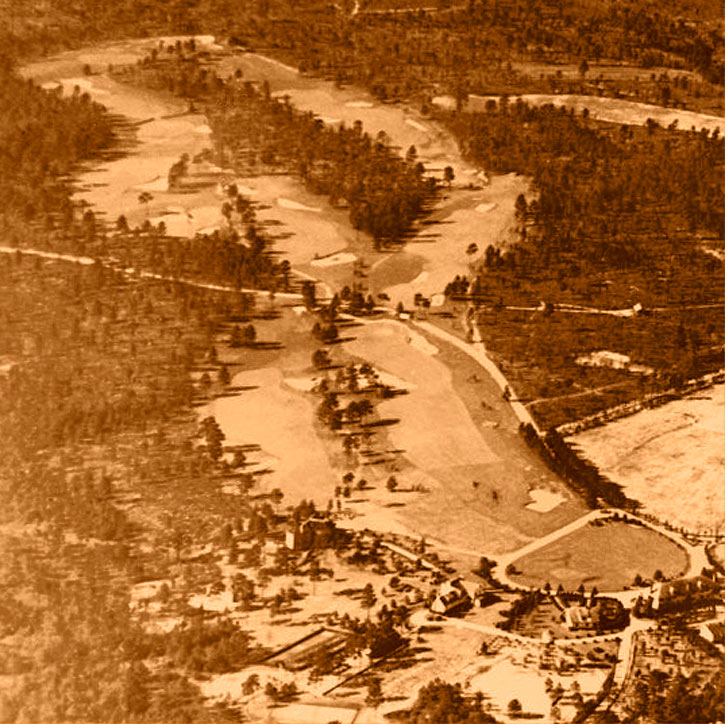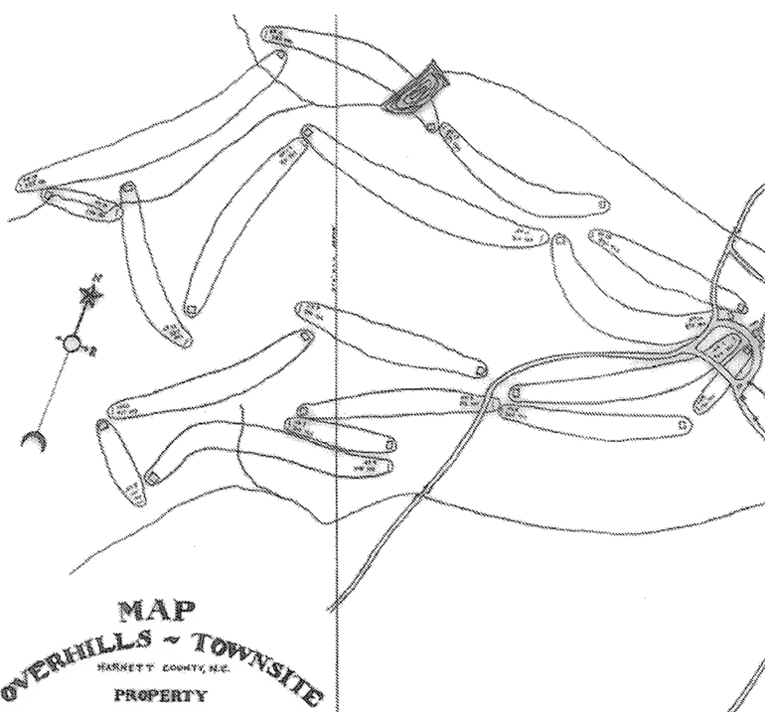Feature Interview with Chris Buie
pg. 2
Please provide an example of a modification to No. 2 which reflects Ross’s evolving design philosophy.
Have a look at the 12th hole. What do you see?
Obviously, the one on the left is earlier because of the sand green. But the part which shows an advancing design philosophy is the cross bunkering. In the earlier image it goes all the way across the fairway. You would just have to make sure your drive was short of that. Not so much in the way of options or thinking – just leave it short of the bunker. In the later version the left side of the fairway has been opened up to tempt the longer player. You could gain an advantage but in order to do that you had to risk putting it in the native area. The later version is much more strategic and chess like. It’s a far more interesting journey when thought is required. So, this is an example of the sort of refinements he made.
How do you think the pros will handle the wire grass and the “rustic areas” during the 2014 Opens?
A part of any U.S. Open is seeing how the player responds to elements they don’t usually see – such as unusually deep rough. Wiregrass is, of course, not something they are used to. Presumably, it may be difficult for some to grasp the idea of a course which emphasizes a sense of adventure rather than almost complete predictability. Complete predictability is just not that interesting or entertaining. These Opens are going to be highly entertaining.
When they do venture into the wiregrass they will encounter any number of scenarios. They may just play off hardpan which is not so difficult – although those shots are known to shift players a bit from the robotic approach to shotmaking and thus produce undesirable results. They may be in one of the plants and thus have to just try to whack it back into the fairway. A fairly common occurrence is the indeterminate lie. That is, there may be a small amount of interference with either the stance or the swing. Those are the situations where you can’t quite tell how the shot will go – or even what type of shot to attempt. We will be seeing a lot of puzzled expressions on the faces of the players.
What’s really being tested or revealed is the players adaptability and attitude. These rustic areas will take the player outside of their normal framework. That’s largely the point. Some players will be lured into a negative frame of mind and get fixated on what they perceive to be unfairness. If they get entrenched in that frame of mind then they are only hurting themselves.
The thing about the rustic areas and also the more difficult collection areas is that if you are in there you either really mishit the shot or you chose to play a shot which brought those areas into play. One of the primary things Ross was trying to do was make thinking and strategy a key element of the game. The game is far more interesting that way than it is when there is little, if any, consideration to the shots being played. So, he spent an enormous amount of time making No. 2 a chess like proposition.
“The object of golf now on will be toward an even greater science of stroke. More and more he will be forced to use his head as well as his hands and arms.” – Donald Ross
The fairways are incredibly wide by U.S. Open standards. If you are a world class player then you shouldn’t have much trouble hitting it in the fairway. If you choose to press for an advantage distance wise then you will sometimes bring the wiregrass into play. Nobody is forcing them to hit a driver on those tee shots. Nobody is making them go for the flag when it is near one of the dangerous drop offs. That’s their strategic decision. If there are deficiencies in their strategic thinking then Mr. Ross will have no problem at all making that entirely clear.
Your book delves deeply into the No. 2 story but let’s move on to another favorite topic of yours: the old Rockefeller estate next to Pinehurst named Overhills.
The first visit out there it was just for a lark really. I’d only vaguely heard of it. My understanding was that they just put up a little golfing area for the Rockefellers. The expectation was to find a run of the mill smallish course – not to stumble on something profound. I clearly remember being struck by the contours of the terrain the first time out. The way the land moved around the knolls and ridges was mesmerizing. But it wasn’t until after reviewing the old course maps and walking through the unkempt area following Ross routing that it became clear the course was a masterwork.
To make sure I wasn’t just getting carried away with notions I had some highly knowledgeable people look out there to confirm the quality. They did. After that I dug deeper into the details and became even more impressed. Ross refined the course at least twice. He did drawings for both. They are extremely detailed drawings. Bunker depths and mounding heights are measured to the inch.

The 203 yard par 4 3rd hole. (Ross crosses his t’s off to the side) – Courtesy of the Ft. Bragg Cultural Resources Center
In retrospect, it’s not difficult to see why it turned out to be so exceptional. All the elements that could give rise to such a creation were in place:
-3,500 acres of ideal sandy golfing land
-An unlimited budget
-An entirely free hand
-Donald Ross
The only request they made was for Ross to create a course “that will have no superior”.
It was an ideal set up and Ross put his maximum level of concentration on it.
While examining the design I dug into the history of the estate. That turned out to be highly uncommon, as well. Rather than reiterate that here you can have a look at the original thread if you like:
https://golfclubatlas.com/forum/index.php/topic,46197.0/
All in all, the entire saga was one of the more fascinating tales I’ve heard.
Is the land in tact enough for the Ross course to be restored?
Absolutely. And if it was restored with the same type of virtuoso performances which occurred at Pinehurst No. 2 and Mid Pines then you would understand why I’ve made so much noise about the place. The corridors as well as the ridges and rolls are still there. And with two sets of extremely detailed sketches you can put it back as he intended it with precision.
The only indeterminate element would be the greens. Grass greens were put in at some point but no documentation or usable photography of that has turned up at this point. That’s not bothersome because there are individuals who understand Ross green design style in such depth that they would have no trouble whatsoever forming something that would fit, not just well, but brilliantly.
Once restored, you think the estate could be used for Wounded Warriors as a primary consideration?
Yes. We just had the longest period of war in the country’s history. If you look at the information you’ll see that there is no question that the response to wounded vets has to be improved. It can be done more effectively with less money spent, actually. There are a number of program options and what I’d recommend, at least in part, is an emulation of the Resilience and Restoration Center in Texas. It’s a prototype program that has proven to be far more effective than standard treatment regimens – with less money spent. The former Rockefeller estate would be an ideal for such a place.
Which courses do you usually play in the area?
Lately I’ve mainly been playing Southern Pines G.C. and Mid Pines the most. The audience on GCA is well aware of the allure of Mid Pines – especially after Kyle Franz and that roving band of artists did such a stellar job.
SPGC is a course that I never get tired of playing. The terrain is so varied and interesting. The manner in which Ross used the landscape is really quite something. One golf super guru told me if SPGC received the same treatment as Mid Pines did, it would be the second best course in the area. Well, that’s the course I play mainly. In addition to the rolling grounds it has a far more substantial historic dimension that most know.
In conclusion, since you have seen all the big events in Moore County over the past couple of decades , do you have a favorite memory?
Yes, sort of. I was playing Pine Needles the day after the 2007 Women’s Open. On 18, I had a 6 iron into the green and hit it way right. It bounced off the angled top of the grandstand and ended up on the edge of the green. I try not to boast but I don’t think there are many who could pull that shot off!
The End














